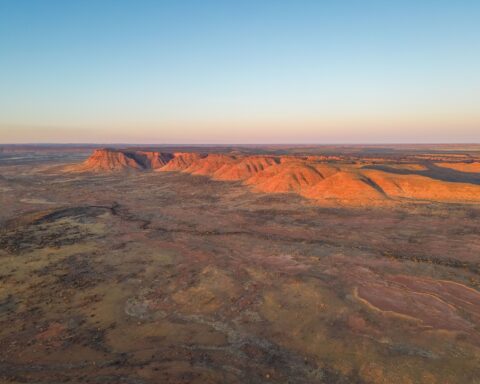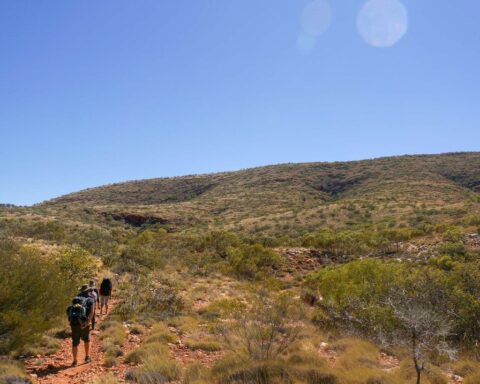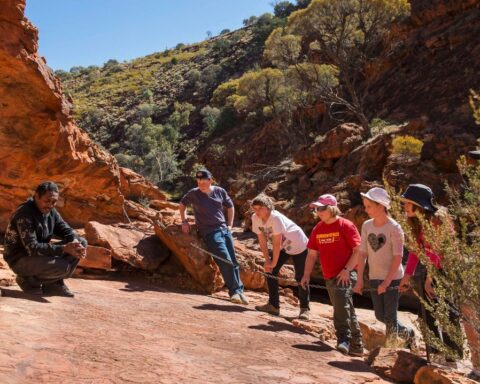Alice Springs is a fascinating town that’s rich in culture, heritage, and history. From the early settlers to the European explorers, Alice has been built up from just a few Aboriginal camps into one of Australia’s top tourist destinations. Take a step back in time and learn how Alice Springs became what it is today.
The traditional owners of Alice Springs and the surrounding area are the Aboriginal Arrernte people, who first settled here thousands of years ago. Their Dreamtime story of Yeperenye (caterpillar) tells of how the region was created by giant caterpillars that lost a battle with their enemies, the stink bugs. As a result, the caterpillars became the stunning ridges of the East and West MacDonnell Ranges, and the gaps in the ridges were created when the caterpillars’ heads were bitten off by the stink bugs. The Arrernte people lived simply in camps, and remain in the area today, passing down their ancient stories, beliefs, values, language, laws, and culture to younger generations as well as visitors.
In 1862, the first European arrived in the area – a Scottish man named John MacDouall Stuart, who was assessing inland Australia for a potential settlement. Following his path, the Overland Telegraph was constructed, with the goal of making it possible for farmers to take up leases in the outback. It was completed in 1872. The Overland Telegraph is considered by many to be the greatest engineering achievement of 19th Century Australia, as it allowed communications between Australia and Europe. Aboriginal camps remained in the area, and many Arrernte people were employed by the station.
During construction, a surveyor noticed a dry riverbed and followed it to discover pools of clear water. He named the waterhole Alice Springs, after the wife of Sir Charles Todd, Superintendent of Telegraphs, who was overseeing the project. The town which we now know as Alice Springs was originally named Stuart.
In 1878 a post office was opened, followed in 1879 by a police station. However, the major turning point wasn’t until 1887, when alluvial gold was discovered at Arltunga, located 110km east. Camel trains began to carry water and supplies from Alice Springs to Arltunga, and many present-day residents of Alice are direct descendants of those cameleers.
In 1888, the town of Stuart was officially proclaimed, after the South Australian government began to build a town on the west banks of the Todd River. It was just 3km from the telegraph station. In 1889, some of Stuart’s earliest businesses were opened, including a store and a hotel. However, Alice Springs and the telegraph station remained a separate community.
The population grew over the next three decades, and by the time that the first plane landed in Stuart, it was home to around 30 whites and 300 Aboriginals. In 1927, the town was declared the administrative capital of Central Australia. In the 1920s railway lines were extended, and by 1929 Stuart and Adelaide were linked by rail. At this point the town was known informally as Alice Springs, however, it caused some confusion, so finally, in 1933, Stuart was officially renamed Alice Springs by the government. At this point, the population was a little over 500 people.
Over the course of World War Two, the town obtained a much cleaner and more extensive water supply, as well as a power station, a new airport, and its own newspaper. The population grew, and by the time the war ended, Alice Springs was home to over 2,000 residents.
Since the end of World War Two, Alice Springs has seen rapid population growth and is estimated to have over 29,000 residents in 2019. Around 18% of the multicultural population are Aboriginal Australians, however people from all over the world call Alice home. Today it is a bustling town that occupies a high spot on the bucket lists of many visitors and tourists in Australia. The Arrernte residents still observe their original culture and laws from all those years ago.
When visiting Alice Springs, there are plenty of ways to observe the history of the town. Head to the Ewaninga Rock Carvings Conservation Reserve to see ancient petroglyphs. Make your way to the Araluen Cultural Precinct for museums, galleries, and a theatre where you can gain a real understanding of the history and culture. Learn all about the overland telegraph line that plays such a critical role in the town’s history, on a tour of the Telegraph Station Historical Reserve, and visit the original Alice Springs waterhole whilst you’re there.




